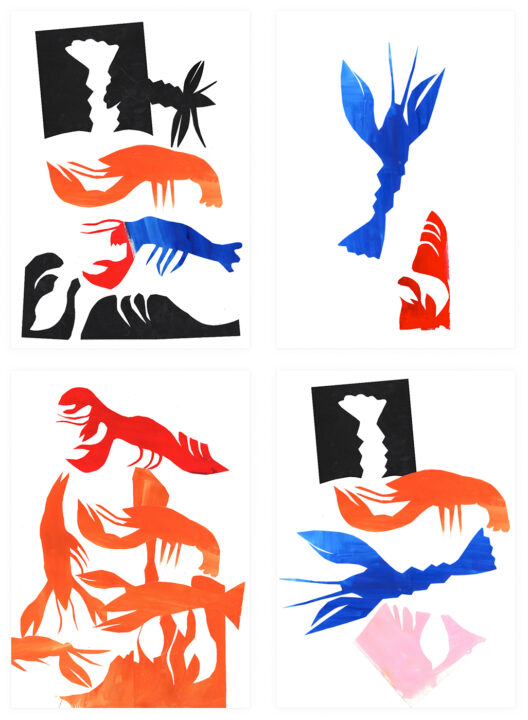
JUBG Edition by Reena Spaulings
4 unique motifs, Holiday, Flight, Ruckus, Apartment, 2025, fine art print on 190 g/m² satin paper, each 84,1 x 59,4 cm, signed, dated, numbered certificate, edition of 15 + 5 AP.
Edition set of all 4 motifs No. 1-5 / 15 + 5 AP for 700 € (exclusive VAT + shipping)
Each motif No. 6-15 / 15 + 5 AP for 200 € (exclusive VAT + shipping)
Reena Spaulings
Keep On Truckin’
Exhibition November 6 – December 13, 2025

For Keep On Truckin’, Reena Spaulings has produced a series of cut-out paintings that repeat a specific hieroglyphic shape, somewhere between a figure and a made-up letter. In fact, this shape comes from a scan of a piece of trash found on the streets of Manhattan: the discarded, flattened-out paper packaging for a set of Apple EarPods. When the shape is rotated ninety degrees, four distinct signs can be articulated with each turn. For two of the paintings, this found sign-figure is combined with a cut-out “acrobat” taken from Matisse.
The cut-out rearticulates painting via a hard “Egyptian” contour, allowing Reena Spaulings to lure painting back from the window-like space of realism, Surrealism, etc. Here, abstraction becomes a sort of figure, and the figure acts like a letter that recodes space. The flattened-out, rotated hieroglyph serves as a vehicle and support for everything else that makes the paintings paintings: color and gesture, speed and light, chaos and kitsch. Monochromatic color schemes evoke the four seasons.
A cut-out acrobat becomes ensnared within the articulations of a rotating sign-apparatus, or perhaps attempts to leap out and escape its coding. Almost a dance, almost an allegory. In some paintings, the two figures (acrobat and hieroglyph) combine to form an abstract chimera, which can also be rotated. Using a technique invented in Los Angeles by Albert Oehlen, these two unstretched canvases are adhered directly to the wall with rubber cement, like giant stickers. The others are mounted on wooden supports to give them a more sculptural presence in the space.
Keep On Truckin’ was first presented at Galerie Chantal Crousel in Paris in 2024. Now it’s a traveling show. In their second installation here at JUBG in Cologne, the downstairs paintings are leaned rather than hung on the walls, and all are rotated in the same direction. The cardboard cross shapes on the exhibition postcard were seen in a church in France, where simple cut-outs were stuck to the stone walls, marking the stations of the cross. Keep On Truckin’ could be Reena Spaulings’s version of Bosch’s allegorical painting The Wayfarer, which depicts a traveler arriving at a crossroads between the past and the future, poverty and abundance, the right way and the wrong way… a forked path that forms a sort of moral or existential or navigational question mark.

Georg Gatsas
Artist book The Process, 144 Pages, 561 four-color process printing plates, 31 x 22,5 cm, with an essay by Ethan Swan. Limited edition to 500 copies. Graphic Design by Dorothee Dähler, Kaj Lehmann. Published by light-years. + Special edition print: Cat, 2006 / 2025, silver gelatin print, 30 x 20 cm, signed, dated, numbered, edition of 15 + 5 AP. Book + print 200 € (exclusive VAT + shipping)
